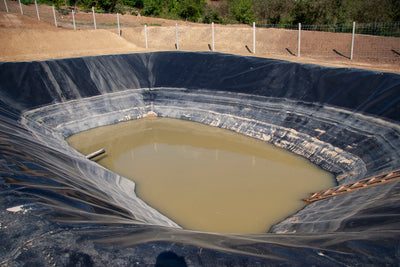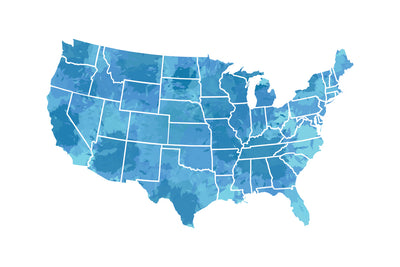Water Quality InformationWritten By Actual Experts
RSSPFAS Water Filters for New York State

Drinking Water Supplies Risk Contamination from Toxic Wastewater Ponds

How Well Do Hydroviv Water Filters Remove Arsenic and Uranium?
Analies Dyjak, M.A. | Policy Nerd
Maine Well Water Case Study:
A prospective customer reached out to us about a year ago with concerns about his well water. After sending the well water test results from an EPA accredited lab to our science team, we were able to determine that his well water water was well above EPA regulatory standards for both arsenic and uranium. This meant that the levels in his well water were above what EPA considers to be safe for human consumption. Private well owners are on their own for determining the safety of their well water.
How Well Did Hydroviv Remove Arsenic and Uranium?
Hydroviv’s Undersink Water Filter brought his arsenic levels down from 23.9 parts per billion to undetectable. For a bit of perspective, his pre-filtered levels were over twice as high as the EPA federal standard for arsenic. Hydroviv filters also brought his uranium levels down from 235 parts per billion to undetectable. His pre-filtered levels were over 7 times higher than the EPA federal standard for uranium. The graph below shows the uranium and arsenic levels, before and after installing a Hydroviv Undersink Water Filter.

Arsenic in Drinking Water:
Arsenic is a naturally occurring heavy metal found in bedrock throughout the United States. Arsenic leaches from bedrock into well water overtime through a process known as natural weathering. The presence of arsenic is entirely dependent on your area’s geology. This means that arsenic may be present in seemingly pristine well water located far away from factories and other sources of pollution. Arsenic can cause various types of cancers, including bladder, lung, liver, and prostate. Some states with the highest rates of bladder cancer also have the highest levels of arsenic in groundwater.
Uranium in Drinking Water:
Uranium is a naturally occurring radionuclide typically found in groundwater. Similar to arsenic, the presence of uranium in well water is dependent on your area’s geology. Long term exposure to uranium in drinking water increases the risk of kidney cancer in humans. The current EPA federal standard for uranium in drinking water is 30 parts per billion. Most standard pitcher and refrigerator pitchers do not include the necessary filtration media to remove uranium from drinking water.
How Do I Know if Arsenic and Uranium are in My Well Water?
Our team of Water Nerds analyzes every order based on the zip code provided at check out. If you live on a private well, we use publicly available USGS data, State Source Water Assessment Program (SWAP) data, municipal Consumer Confidence Reports (CCR), and other internal well water test results. Using these data, we are able to determine the contaminants that are likely present in your well water.
Other Articles Recommended For You:5 Things That Most People Don't Realize About Well Water
Home Water Testing: What You Should Know
How is EPA Responding to COVID-19?
PFAS: Everywhere We Look, We Find It

How Changes to the WOTUS Rule Affect Drinking Water
Analies Dyjak & Eric Roy, Ph.D.
**UPDATE January 23, 2020: EPA Introduces Navigable Waters Protection Rule to replace WOTUS**
Editor's Note: Today, the US EPA and US Army Corps Of Engineers announced that they repealed the Clean Water Rule, and redefined which waters are regulated by the federal government under the Waters Of The United States (WOTUS) Rule. The purpose of this article is to inform the public how this regulatory change can impact their drinking water. We will be updating this article continuously as we learn more and to answer frequently asked questions about changes in U.S water quality standards.
What Is WOTUS?
Waters Of The United States (WOTUS) defines which bodies of water the Federal Government can regulate under the Clean Water Rule. In 2015 the Obama Administration worked to establish a definition for which waters can be regulated waters with the intent of protecting drinking water, ecosystems, wetlands, and endangered species. Most importantly for U.S. water quality standards, WOTUS definitions provided coverage to groundwater, as roughly 50% of the US population drinks groundwater, including the 15% of people who draw drinking water from private wells. The new WOTUS definition basically removes these protections, among other things.
How Will The New WOTUS Definition Impact Drinking Water?
In the press conference, EPA officials mentioned that the new change does not change the Safe Drinking Water Act (SDWA). This is intentionally misleading because private wells are NOT protected by the SDWA, and by removing federal protection from groundwater in general, the Trump administration is removing the only protection for people who have private wells, so those people really should be regularly testing their water quality, which is a giant financial burden to the citizen.
What Is Considered A Water Of The United States Under The Proposed Rule?
- Traditional navigable waters
- Tributaries
- Navigable ditches
- Lakes
- Impoundments
- Wetlands
What Is NOT Considered A Water Of The United States Under The Proposed Rule?
- Groundwater
- Water features
- Farm ditches
- Converted cropland
Who Drove The Legislation To Roll Back These Protections?
A coalition of lobbyists from various business organizations, led by the American Farm Bureau was responsible for driving this legislation. In fact, the American Farm Bureau had representatives from western agricultural states in the press conference audience.
What Can Citizens Do To Be Heard On The Topic?
As with any proposed rule, there is a public comment period. Our experts will be submitting public comments to the Federal Register. Once the link is live, we'll be posting it here.




